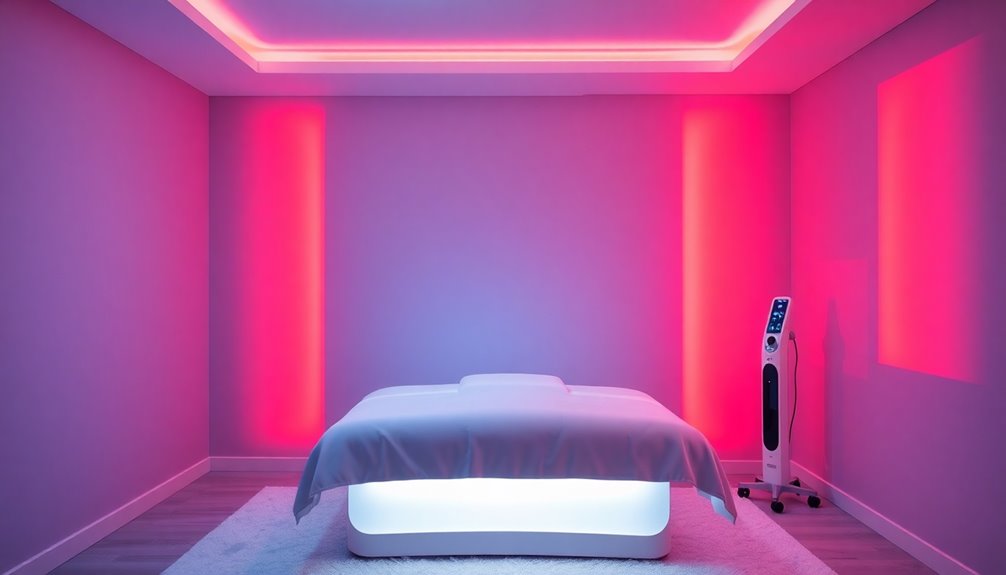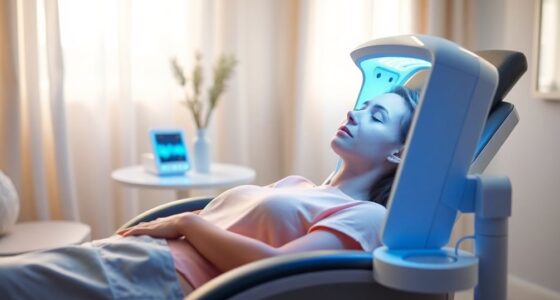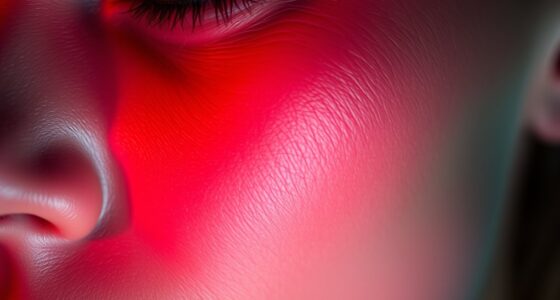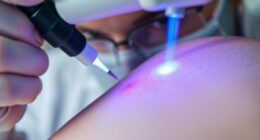To combine red and blue light therapy for maximum results, use devices that emit specific wavelengths: 630 nm for red and 415 nm for blue. Start with blue light to target bacteria and reduce inflammation, followed by red light to enhance healing and boost collagen production. Aim for regular sessions, ideally twice a week, and limit each treatment to around 20 minutes to allow your skin to adjust. Always protect your eyes and monitor your skin's reaction. With this approach, you can achieve a brighter and healthier complexion while addressing common skin concerns. There's much more to explore on optimizing your therapy.
Key Takeaways
- Use devices emitting specific wavelengths: 630 nm for red light and 415 nm for blue light for effective treatment.
- Begin with blue light therapy to target bacteria, followed by red light to reduce inflammation and promote healing.
- Maintain a consistent treatment schedule, ideally twice weekly, for optimal results in managing acne and improving skin texture.
- Monitor skin response and adjust treatment duration, limiting sessions to around 20 minutes to prevent overexposure.
- Consult with a professional for personalized guidance and to ensure safety, especially if you have skin sensitivities.
Understanding the Benefits
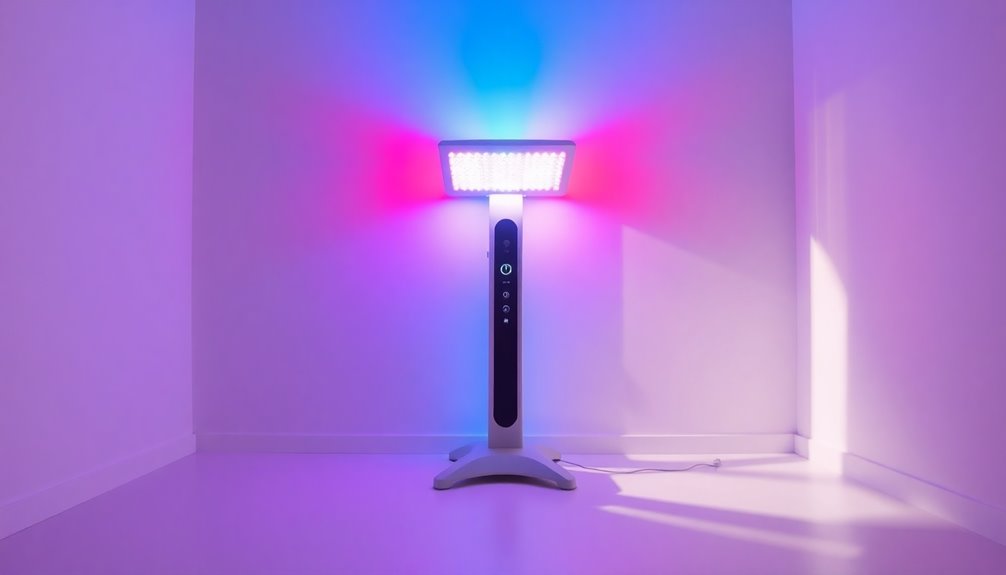
When you combine red and blue light therapy, you unlock a range of remarkable benefits for your skin. This powerful duo reduces chronic inflammation, effectively calming conditions like acne and rosacea. Blue light therapy's ability to target bacteria complements red light's anti-inflammatory effects, providing comprehensive relief from skin irritation. Additionally, both therapies enhance circulation, stimulating nitrous oxide production and promoting blood flow. Combining these therapies has also been shown to increase blood circulation through nitrous oxide production, further enhancing the skin's overall health. Improved circulation not only accelerates healing but also enhances skin texture and tone, leaving you with a smoother, more even complexion. By stimulating collagen production, these therapies tackle visible signs of aging, helping you achieve a brighter, more youthful appearance. Experience these benefits and transform your skin with red and blue light therapy!
Mechanisms of Action
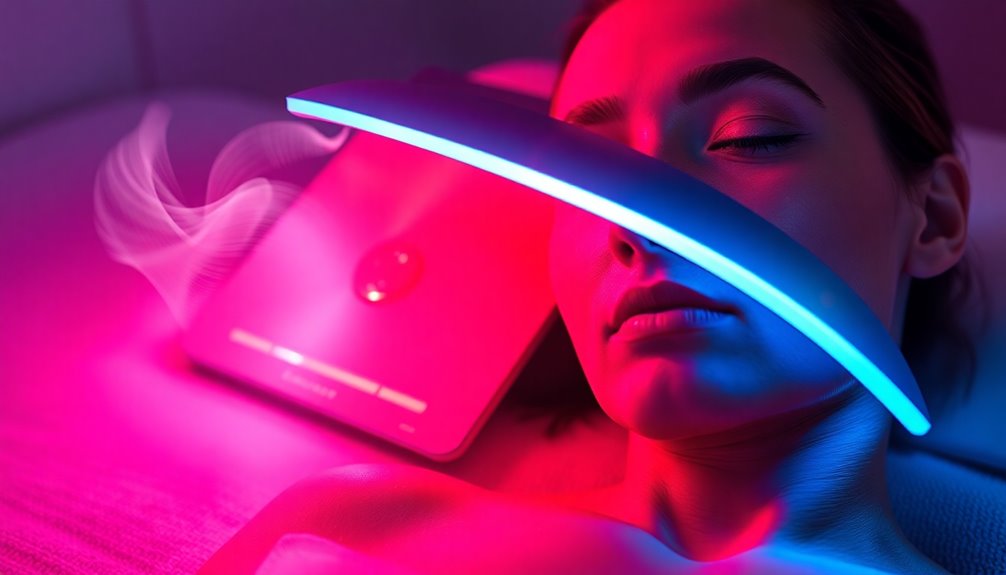
Understanding the mechanisms of action behind red and blue light therapy reveals how effectively these treatments work to improve your skin.
Red light therapy activates mitochondria, boosting adenosine triphosphate (ATP) production, which enhances cellular energy and supports tissue repair and rejuvenation. It promotes collagen production, reducing fine lines and improving elasticity. Additionally, red light exposure can enhance metabolic processes, which contributes to overall skin health. The antimicrobial properties of blue light also help in maintaining clear skin by targeting harmful bacteria.
On the other hand, blue light therapy targets bacteria, producing reactive oxygen species that kill acne-causing bacteria and reduce inflammation.
Together, these therapies create synergistic effects—red light penetrates deeper, while blue light works on the surface. This combination not only improves skin barrier function but also reduces inflammation and bacterial growth, maximizing your skin's healing and rejuvenation potential.
Practical Application
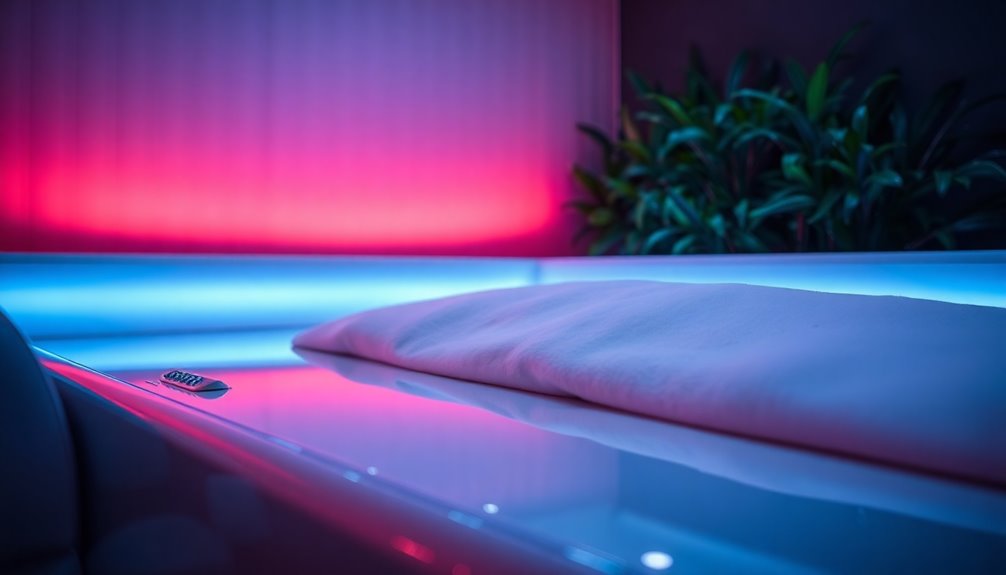
Combining red and blue light therapy in practical applications can significantly enhance your skincare routine.
Start by selecting a device that emits specific wavelengths—630 nm for red and 415 nm for blue light. Check the power output to ensure it aligns with your therapeutic goals.
Follow recommended treatment protocols, targeting acne management by utilizing blue light to eliminate bacteria while red light reduces inflammation and promotes healing. This combination therapy is particularly effective for addressing skin concerns such as acne and overall skin vitality.
Consistency is key, so maintain a regular regimen for optimal results. Consider individual skin conditions and adjust treatments accordingly.
For comprehensive care, use full-body LED panels and ensure proper calibration.
Regularly monitor your progress and consult a professional for guidance to maximize your outcomes safely and effectively.
Safety Considerations

While exploring red and blue light therapy, it's crucial to prioritize safety to ensure effective and worry-free treatments.
First, choose FDA-cleared devices that emit the correct wavelengths, like 660 nm for red and 415 nm for blue light. Look for integrated safety features, such as timers and overheating prevention.
Always prepare your skin by cleaning it and protecting your eyes with goggles during treatment. Be cautious if you have skin sensitivity or pre-existing conditions—consult a doctor if needed. Additionally, consider that red light therapy is generally considered safe when used correctly, enhancing your confidence in the treatment.
Keep sessions to around 20 minutes and adjust frequency based on your skin's response.
Lastly, monitor for any adverse reactions, and follow the manufacturer's instructions to maximize safety and efficacy.
Research and Evidence
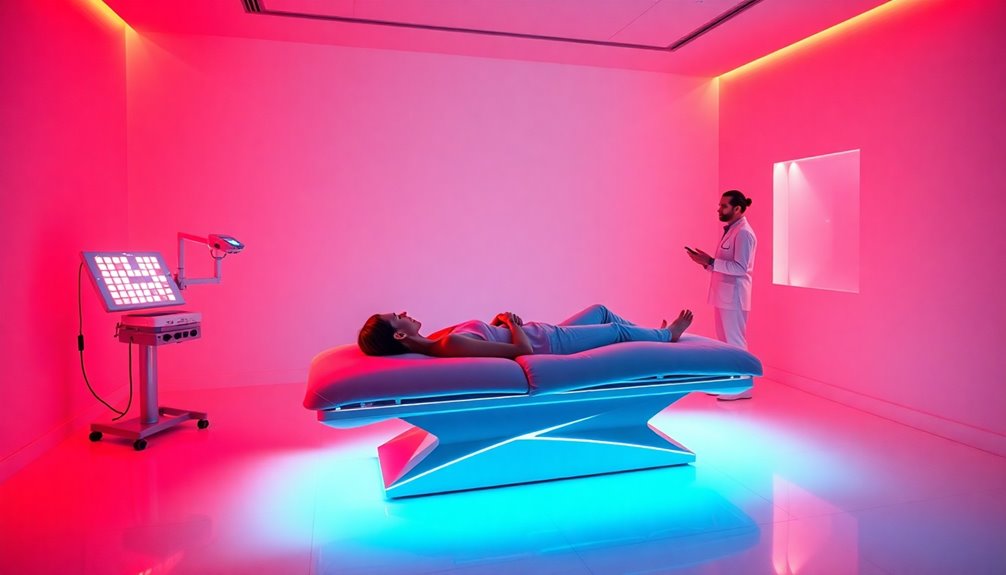
Research into red and blue light therapy reveals significant evidence supporting its effectiveness, particularly in treating acne.
Blue light targets Propionibacterium acnes, while red light boosts mitochondrial function, leading to enhanced tissue repair. When combined, these therapies show notable improvements in both non-inflammatory and inflammatory lesions, with studies reporting an average improvement of 34.28% and 77.93%, respectively. Moreover, the combination of these therapies can reduce oxidative stress, further enhancing the overall skin healing process.
Patients often notice brighter skin tone and improved texture after treatment. Instrumental measurements confirm a decrease in melanin levels, further validating the therapy's efficacy.
Conducted twice weekly over four weeks, this combined approach demonstrates sustained benefits without significant short-term adverse effects, making it a promising option for managing mild to moderate acne vulgaris.
Synergistic Benefits

The combined application of red and blue light therapy offers remarkable synergistic benefits that enhance treatment outcomes. This innovative approach leverages the unique properties of both wavelengths, promoting enhanced cellular regeneration and improved circulation. With red light therapy benefits such as increased collagen production and reduced inflammation, patients often experience faster healing times and superior skin health. Furthermore, the incorporation of blue light therapy targets acne-causing bacteria, making this combined treatment an effective solution for various skin concerns.
You'll experience improved cellular energy as blue light activates proteins that stimulate mitochondria, while red and near-infrared wavelengths penetrate deeper, boosting energy production. This combination increases ATP levels, vital for cellular health. Additionally, red light promotes collagen synthesis, further enhancing skin rejuvenation.
Moreover, these therapies work together to reduce inflammation, addressing chronic pain and various skin disorders like acne and rosacea.
The enhanced circulation from blue light stimulates nitrous oxide production, expanding blood vessels, while red light promotes endothelial cell growth, ensuring optimal oxygenation and nutrient delivery.
Lastly, expect increased collagen and elastin production, leading to firmer, more elastic skin. Together, these effects create a powerful therapeutic synergy.
Frequently Asked Questions
How Long Does It Take to See Results From Combined Therapy?
You can expect to see noticeable improvements from combined therapy within 2 to 4 weeks, especially with consistent sessions two to three times a week.
After about 12 weeks, many users report significant reductions in acne lesions and overall skin texture.
For the best results, stick to your treatment schedule and consider using professional-grade devices for more severe cases.
Patience and consistency are key to achieving optimal outcomes.
Can I Use Red and Blue Light Therapy on Sensitive Skin?
Sure, go ahead and slap on some blue and red lights on your sensitive skin—what could possibly go wrong? Just kidding!
You'll want to approach this combo with caution. It's crucial to minimize exposure, use protective eyewear, and consult a dermatologist to tailor the treatment for your skin type.
With the right precautions, you can enjoy the benefits while keeping your sensitive skin safe and sound. So, proceed wisely!
Is There an Age Limit for Using Light Therapy?
There isn't an age limit for using light therapy, which means you can benefit from it at any stage of life.
However, if you're a young teenager, it's best to avoid laser exposure. Generally, younger individuals might see better results due to healthier skin.
Just remember to follow recommended treatment durations—typically 5-15 minutes several times a week—to ensure safety and effectiveness as you explore light therapy options.
Can I Perform These Treatments at Home Safely?
Absolutely, you can engage in these treatments at home, provided you're mindful of a few essential factors.
First, choose FDA-approved devices that suit your skin type. Adhere to recommended durations and frequencies to ensure your safety.
Always use protective eyewear and maintain the devices properly.
By following these guidelines, you can create a nourishing environment for your skin while minimizing risks.
Just pay attention to any adverse effects, and you'll be on your way!
Are There Any Specific Skin Types That Benefit Most From This Therapy?
Yes, certain skin types benefit significantly from red and blue light therapy.
If you have acne-prone skin, this therapy can reduce lesions and regulate oil production.
For aging skin, it boosts collagen and improves texture.
If your skin's sensitive, the anti-inflammatory properties can calm irritation.
Lastly, for hyper-pigmented skin, it helps balance skin tone.
Each skin type can experience unique improvements, making this therapy a versatile choice for various concerns.
Conclusion
Just like a painter blends red and blue to create vibrant purple, combining red and blue light therapy can enhance your wellness canvas. By harnessing their unique benefits, you're not just layering colors; you're crafting a masterpiece of health. As you navigate this therapeutic journey, remember to stay informed and attentive to your body's needs. With the right approach, you'll illuminate your path to optimal results, turning your health aspirations into a brilliant reality.
